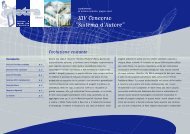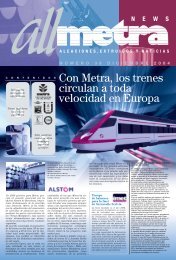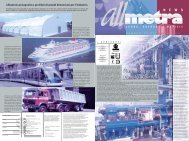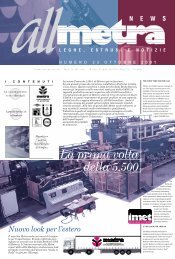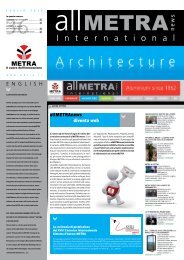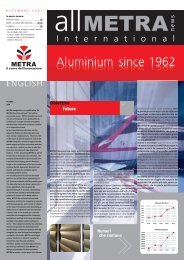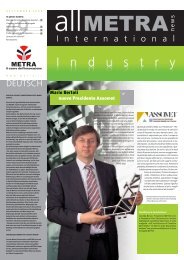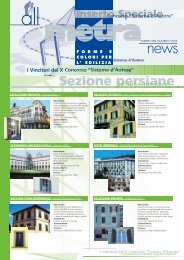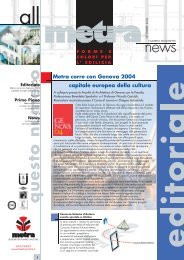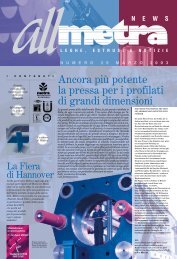Compal curva oltre l'impensabile. - Metra SpA
Compal curva oltre l'impensabile. - Metra SpA
Compal curva oltre l'impensabile. - Metra SpA
You also want an ePaper? Increase the reach of your titles
YUMPU automatically turns print PDFs into web optimized ePapers that Google loves.
T R A S P O R T I<br />
Il pianale del nuovo treno delle ferrovie danesi<br />
N E W S<br />
L’alluminio per le sue doti di<br />
leggerezza abbinata alla<br />
resistenza ed alla robustezza,<br />
nonché alla facilità<br />
di lavorazione si è<br />
affermato nel mondo dei<br />
trasporti ed in particolare<br />
nel segmento ferroviario.<br />
L’estruso che presentiamo, di<br />
dimensioni particolarmente significative,<br />
45 mm di altezza, 580 mm di larghezza,<br />
per 18 kg/m, dà forma al pianale<br />
del nuovo treno delle ferrovie danesi<br />
progettato da AnsaldoBreda.<br />
La struttura di una carrozza ferroviaria<br />
può essere composta da 40/45 profilati<br />
d’alluminio di grandi dimensioni<br />
che oggi <strong>Metra</strong> è in grado di poter fornire.<br />
La produzione di questo estruso è<br />
una chiara dimostrazione delle enormi<br />
potenzialità della nuova linea di estrusione<br />
con pressa da 5500 ton che permette<br />
di confezionare prodotti di proporzioni<br />
fuori dell’ordinario; profilati<br />
a sezione quadrata da 300 x 300 mm<br />
oppure da 600 x 70 mm, pesanti fino a<br />
50 kg/m, e, compatibilmente con il peso<br />
della billetta, lunghi fino 25 metri.<br />
altezza: 45 mm - larghezza: 580 mm - peso: 18 kg/m,<br />
L E G H E , E S T R U S I E N O T I Z I E<br />
N U M E R O 2 4 D I C E M B R E 2 0 0 1<br />
S t a m p e n o n p e r i o d i c h e - S p e d . i n a b b . p o s t . - M i l a n o S t a m p a G r a f i c h e S o m a l i a - C o r m a n o<br />
N A U T I C A<br />
THE PLATFORM FOR DANISH<br />
RAILWAYS’S NEW TRAIN<br />
A R R E D O C U C I N A<br />
COGNOME E NOME<br />
AZIENDA<br />
DIVISIONE<br />
INDIRIZZO<br />
CAP CITTÀ<br />
Nº TELEFONO<br />
Un albero<br />
tutto<br />
d’alluminio<br />
E’ alto 18 metri, ha una sezione di<br />
400x220 mm, pesa 27 kg ed è in lega<br />
6005/a: è il profilato tubolare dell’albero<br />
maestro di un nuovo prestigioso<br />
yacht. La particolare sagoma, realizzata<br />
in un unico pezzo, consente da un<br />
lato di rendere minima la resistenza<br />
all’aria grazie alla sua forma aerodinamica<br />
e, contestualmente, dall’altro permette<br />
di inferire la vela in un’apposita<br />
canaletta. Questo profilato tubolare<br />
nella sua parte terminale viene rastremato<br />
per assumere la consueta forma<br />
Prodotta da Emmegi la nuova macchina<br />
per il caffè espresso in casa è, nelle<br />
sue parti strutturali, interamente in<br />
alluminio. La scocca si compone di due<br />
profilati tubolari. Il primo che contiene<br />
la caldaia, la pompa ed il serbatoio dell’acqua,<br />
l’altro è il frontale nel quale<br />
alloggia la pulsantiera e la vaschetta<br />
per la raccolta dell’acqua in eccesso.<br />
L’estruso è stato realizzato in lega 6060.<br />
Rispetto alla plastica ed agli altri materiali<br />
solitamente usati l’alluminio in<br />
altezza: 18 metri - sezione: 400x220 mm - peso: 27 kg<br />
del pennone. La scelta dell’alluminio<br />
nel settore nautico è determinata dalle<br />
specifiche caratteristiche del materiale:<br />
leggero, robusto, elastico e resistente alla<br />
questo particolare tipo di applicazione<br />
presenta numerosissimi vantaggi.<br />
Innanzi tutto di tipo economico: produrre<br />
una pre-serie in alluminio<br />
comporta un risparmio fino<br />
all’80% rispetto alla costruzione<br />
di uno stampo per la plastica.<br />
In<strong>oltre</strong> l’alluminio è<br />
più robusto e consente delle<br />
finiture di maggior prestigio<br />
a tutto vantaggio dell’immagine<br />
del prodotto.<br />
DESIDERO RICEVERE<br />
INFORMAZIONI SU METRA<br />
SUGGERISCO UN INCONTRO IL (data)<br />
ALLE (ore)<br />
RICHIEDO MATERIALE<br />
INFORMATIVO SULLE VOSTRE ATTIVITÀ.<br />
I SOGGETTI CHE MI INTERESSANO<br />
SONO I SEGUENTI:<br />
PROFILATI A DISEGNO<br />
FINITURE (verniciature, ossidazioni)<br />
LAVORAZIONI MECCANICHE<br />
(fresature, <strong>curva</strong>ture)<br />
ALTRO (specificare)<br />
corrosione della salsedine. Anche questa<br />
realizzazione è stata possibile grazie<br />
alla nuova linea d’estrusione con pressa<br />
da 5500 ton.<br />
L’alluminio per un buon caffè<br />
<strong>Metra</strong> s.p.a. garantisce la massima riservatezza<br />
dei dati forniti e la possibilità di richiederne la rettifica<br />
o la cancellazione scrivendo a METRA<br />
S.P.A. via Stacca,1 - 25050 RODENGO SAIANO<br />
(BS). I dati verranno utilizzati al solo scopo di<br />
inviarle proposte commerciali. In conformità alla<br />
legge 675/96 sulla tutela dei dati personali.<br />
COUPON DA COMPILARE E SPEDIRE A:<br />
METRA S.P.A.<br />
VIA STACCA, 1<br />
25050 RODENGO SAIANO (BRESCIA)<br />
ITALY<br />
N. FAX +39/30/6819991<br />
http://www.metra.it<br />
E.mail: industry@metra.it<br />
Owing to its light weight, its resistance and toughness<br />
and the ease with which it can be machined,<br />
aluminium has established itself at the heart of<br />
the transport world – in particular in the railway<br />
industry.<br />
The large extruded piece presented here has a<br />
weight of 35 kg per metre, is 600 mm long and 65<br />
mm high and provides the platform of the new<br />
Danish Railways train designed by Ansaldo<br />
Breda. The structure of a railway carriage can be<br />
made up of 40/45 large aluminium sections of the<br />
kind that <strong>Metra</strong> is proudly able to produce.<br />
This extrusion is testament to the enormous<br />
potential of the new 5500 tonne press, which<br />
allows for the production of products of remarkable<br />
proportions: 300 mm x 300 mm; or 600 mm x<br />
70 mm; weighing up to 50 kg per metre; up to 25<br />
metres long.<br />
A MAST MADE ENTIRELY OF ALUMINIUM<br />
18 metres high, cross section of 420 mm x 220<br />
mm, weighing 27 kg - the 6005 alloy tubular section<br />
for the main mast of a new prestige yacht.<br />
This special mast is made in a single piece and<br />
enables air resistance to be kept to a minimum. It<br />
has a streamlined shape and provides a groove for<br />
the sheets of the sails. The section is tapered on<br />
the tip to give it the unusual shape of a yard.<br />
The choice of aluminium is ideal for the field of<br />
yachting: it is lightweight, strong, flexible and<br />
resistant to salt-corrosion.<br />
This is another achievement made possible by the<br />
new extrusion line with the 5500 tonne press.<br />
ALUMINIUM FOR MAKING GOOD COFFEE<br />
Emmegi has developed a new espresso coffee<br />
machine for the home kitchen made entirely with<br />
aluminium structural parts. The body is made up<br />
of two tubular sections. The first contains the boiler,<br />
the pump and the water tank. The other is the<br />
front, in which the push-button panel and the<br />
small excess water collection tank are housed.<br />
The extruded piece is made of 6060 alloy, which<br />
demonstrates many advantages over plastic and<br />
other materials traditionally used for this application.<br />
First of all it is inexpensive: manufacturing a<br />
pre-series made of aluminium gives a saving of up<br />
to 80% in comparison with making a plastic<br />
mould. Furthermore, aluminium is tougher and<br />
allows for a greater quality finish enhancing the<br />
product’s aesthetic value.<br />
I C O N T E N U T I<br />
Il moderno tram<br />
in lega leggera<br />
2<br />
terza parte<br />
Il pianale<br />
4<br />
del nuovo treno<br />
delle ferrovie danesi<br />
PROTAGONISTI<br />
DI UN’EPOCA<br />
L’alluminio<br />
4 per un buon caffè<br />
Tutta <strong>Metra</strong> Industria<br />
in Cd-rom<br />
Tutta la produzione di <strong>Metra</strong><br />
Industria è racchiusa in questo<br />
CD-ROM. Ben 14 cataloghi che<br />
spaziano dai dissipatori ai profilati<br />
a disegno per l’industria e<br />
per l’edilizia, dalle guide lineari<br />
fino alla presentazione degli<br />
esempi dimensionali che si possono<br />
realizzare con tutte le presse del Gruppo <strong>Metra</strong>.<br />
<strong>Compal</strong><br />
<strong>curva</strong> <strong>oltre</strong><br />
l’impensabile.<br />
E’ di grandi dimensioni e garantisce prestazioni<br />
semplicemente eccezionali, 7 metri di base, 2<br />
d’altezza per una profondità di 3: è la più grande<br />
macchina mai progettata ed installata in<br />
Europa per la <strong>curva</strong>tura di profilati in alluminio.<br />
La nuova <strong>curva</strong>trice è operativa dalla fine<br />
di maggio del 2001, nello stabilimento di<br />
Rodengo Saiano. <strong>Compal</strong>, la società del Gruppo <strong>Metra</strong> specializzata<br />
nelle lavorazioni meccaniche, con questo impianto unico ed innovativo,<br />
che ha comportato un investimento di <strong>oltre</strong> 5 milioni di €, ha raggiunto<br />
un altro importante traguardo che la pone ai vertici del suo mercato.<br />
La nuova <strong>curva</strong>trice ha la possibilità di piegare profilati d’alluminio<br />
con un modulo resistente fino a 1.700 cm 3 e con una sezione massima<br />
fino a 550 x 550mm. Un risultato eccezionale che pone un amplissimo<br />
divario tra <strong>Compal</strong> ed i suoi concorrenti. Nell’ambito dei grandi<br />
estrusi le applicazioni che sono servite da <strong>Compal</strong> spaziano dal settore<br />
dell’edilizia (facciate continue) a quello industriale (ponti, parti<br />
navali, carrozze ferroviarie, coperture speciali) alla meccanica di<br />
precisione (automotive, elettromedicale, arredamento e meccanica in<br />
genere). L’installazione del nuovo impianto <strong>Compal</strong> si affianca<br />
alla linea d’estrusione con pressa da 5,500 ton,<br />
inaugurata nello scorso novembre e rientra in<br />
una più ampia ed articolata<br />
strategia di Gruppo.<br />
Imet<br />
e automotive<br />
Imet entra con autorevolezza nel mercato dell’automotive<br />
ed acquisisce la fornitura di profilati<br />
d’alluminio per la sportwagon 156 dell’Alfa<br />
Romeo. A Imet è stata affidata la produzione del<br />
carter che contiene il telo copri bagagliaio ed il<br />
retino di separazione dell’abitacolo.Una commessa<br />
che evidenzia l’alto standard qualitativo raggiunto<br />
per rispondere alle crescenti esigenze estetiche<br />
e di precisione del settore automotive.<br />
COMPAL ARE BENDING THE<br />
UNTHINKABLE AND BEYOND<br />
The largest machine for bending aluminium<br />
extrusions ever designed and<br />
installed in Europe provides for simply<br />
exceptional performance. The sectionbending<br />
machine covers a base area of 7<br />
metres by 3 metres and is 2 metres high.<br />
It has now been operating since the end<br />
of May 2001 at the <strong>Compal</strong> plant in<br />
Rodengo Saiano.<br />
The unique and innovative system is<br />
resultant of a 5 million Euro investment<br />
and has promoted <strong>Compal</strong> to the leading<br />
position in the mechanical processing<br />
market. <strong>Compal</strong> can now bend aluminium<br />
sections with a section modulus of up to<br />
1700 cm3 and with a maximum cross section<br />
of 550 mm square.<br />
This exceptional achievement provides<br />
for a huge gulf between the capabilities<br />
of <strong>Compal</strong> and their most qualified competitors.<br />
<strong>Compal</strong>’s new bending machine provides<br />
a gateway to supply large extruded products<br />
for a multitude of applications, ranging<br />
from construction (continuous facades)<br />
to industry (bridges, shipbuilding,<br />
train carriages, special covering) and<br />
precision mechanics (automotive, electromedical,<br />
furniture, general mechanics).<br />
These new developments are intrinsic to<br />
a wider <strong>Metra</strong> Group strategy that has<br />
also recently included the inauguration of<br />
the 5500 tonne extrusion press at the<br />
<strong>Metra</strong> factory. The new press and the<br />
new bending facility will complement<br />
each other in serving the market’s<br />
demands for large processed extrusions.<br />
IMET & AUTOMOTIVE<br />
Imet has taken an impressive stride into<br />
the automotive market, securing a contract<br />
to supply aluminium sections for<br />
the 156 Alfa Romeo Sportwagon.<br />
Imet has been entrusted with the manufacture<br />
of the casing which holds both the<br />
cover for the Sportwagon’s luggage compartment<br />
and the net which separates<br />
the luggage compartment from the passenger<br />
area. This contract underlines the<br />
high quality standard that has been<br />
achieved to meet the demanding aesthetic<br />
and precision requirements of the<br />
automotive industry.<br />
THE WHOLE OF METRA<br />
INDUSTRIA ON CD-ROM<br />
The comprehensive product portfolio of<br />
<strong>Metra</strong> Industria has been catalogued on<br />
a single CD-Rom.<br />
All of the current 14 brochures – individually<br />
covering everything from heat<br />
sinks to pneumatics and linear guides –<br />
are presented along with guides to the<br />
dimensional capabilities of the various<br />
presses, thus providing an exhaustive<br />
illustration of <strong>Metra</strong>’s impressive range<br />
of products and services.
H I G H - T E C H<br />
A L L U M I N I O P R O T A G O N I S T A<br />
Il moderno tram in lega leggera<br />
Parte conclusiva<br />
THE MODERN LIGHT-ALLOY TRAM<br />
- LAST PART –<br />
Prospects for innovation.<br />
It is felt that there are imminent innovations in<br />
respect to the way in which tram bodies are designed.<br />
In particular it seems that the near future<br />
will see side panels becoming semi-structured,<br />
comprised of bolted panels that can be removed<br />
and replaced rapidly when necessary.<br />
The experience of a rail Company with a prototype<br />
tram is worthy of note. The side panels of<br />
all of the bodies were designed in the form of<br />
three large extruded multi-hollow panels connected<br />
to each other by means of a two-sided snapon<br />
joint supplemented by an epoxy glue.<br />
Research is now focused upon the mechanical<br />
fixing of the panel to the rest of the structure in<br />
order to comply with the following two requirements:<br />
- ability of the panel to contribute towards the<br />
transmission of sheer forces when the whole<br />
side bends<br />
- possibility of removing the internal linings and<br />
creating accessibility to the fixing points.<br />
A further development concerns the adaptation<br />
of the extruded parts of the side and roof in<br />
order to allow the internal finishing linings to be<br />
fitted rapidly. These are designed in the form of<br />
pultruded sections made of thermosetting plastic<br />
loaded with glass fibre.<br />
Pultruded aluminium is manufactured in a similar<br />
way to extruded aluminium in that the material<br />
passes through a die-plate. The geometrical<br />
similarity makes it possible to join the pieces by<br />
coupling them together, thus speeding up the<br />
preparation and finishing operations.<br />
A third possible development concerns floors<br />
with a transverse structure. This would be very<br />
advantageous in terms of weight gain, especially<br />
if applied to the central bodies. The essential<br />
function of bending strength continues to rely<br />
upon several longitudinal members – under the<br />
doors, above the windows and between the roof<br />
and the side. After proper sizing, arrangement of<br />
a set of traverse ending on the two longitudinal<br />
members becomes feasible.<br />
Comparative studies have been conducted on<br />
two construction solutions, one longitudinal and<br />
one crosswise; the two were comparable in terms<br />
of bending stiffness and fatigue strength when<br />
subjected to cyclic vertical loads. In both cases<br />
reference was made to a floor 12 metres long and<br />
2.4 metres wide. The size of the cross-section of<br />
the piece was also chosen with the same dimensional<br />
limits (width 400 mm, height 60 mm, thickness<br />
3 mm).<br />
The first solution - longitudinal structure – was<br />
designed as follows:<br />
- 6 multi-hollow extruded sections, with a tubular<br />
cross-section with six reticular cavities<br />
- weight of the section 12.4 kg per metre<br />
- unit weight of the floor panel 31 kg per square<br />
metre<br />
- overall floor panel weight 893 kg<br />
- sections connected by means of 10 longitudinal<br />
weld beads<br />
- overall length of the welds (including those to<br />
the 2 longitudinal members): 168 m<br />
The second solution – transverse structure – was<br />
designed as follows:<br />
- 30 extruded open cross-section members of<br />
the floor-panel type with four feet<br />
- weight of the section 8.1 kg per metre<br />
- unit weight of the floor panel 20.25 kg per<br />
square metre<br />
- overall floor panel weight 583 kg<br />
- overall length of the welds(including those to<br />
the 2 longitudinal members):87.12m<br />
The choice of the typology of the two resisting<br />
cross-sections was made in such a way as to<br />
obtain the same level of mechanical performance<br />
in functioning as an infected beam subjected to a<br />
vertical load.<br />
Having defined the geometry of the two extruded<br />
sections to be compared, a comparative<br />
study of the resistance to bending stress was<br />
performed. The calculations gave rise to equivalent<br />
safety coefficients for the two solutions for<br />
the floor panel.<br />
The advantage of the transverse solution lies in<br />
the weight. The longitudinal structure weighs<br />
53% more, and the total length of the welded<br />
seams is double.<br />
All <strong>Metra</strong> News<br />
Leghe, estrusi e notizie<br />
Stampe non Periodiche<br />
Spedizione in Abbonamento Postale<br />
Milano<br />
Stampa Grafiche Somalia<br />
Coordinamento editoriale<br />
e art direction<br />
Partners in Business Communications<br />
Prospettive di innovazione.<br />
Si avverte l’ imminenza di una prossima evoluzione nel concepire la cassa tramviaria, in particolare<br />
per quanto riguarda la fiancata. Infatti viene sollevata l’ esigenza, specialmente da parte del<br />
Manutentore del veicolo, di predisporre una fiancata semi-strutturale, realizzata con pannelli imbullonati<br />
e amovibili, per la rapida sostituzione dopo un eventuale danneggiamento.<br />
E’ intuibile infatti che, nel traffico urbano promiscuo, la fiancata – indubbiamente bassa – sia piuttosto<br />
esposta agli urti da parte di altri veicoli.<br />
Tra le esperienze in questa direzione è degna di nota quella condotta da una grande Azienda<br />
Ferroviaria Italiana su un prototipo marciante non entrato in produzione, ove le fiancate di tutte le<br />
casse erano concepite con tre grandi pannelli estrusi multicava, collegati tra loro mediante una giunzione<br />
a scatto bifacciale, integrata da collante epossidico. Lo stadio della ricerca sull’ argomento<br />
“fiancata intercambiabile” è attualmente imperniato sul tipo di fissaggio meccanico del pannello alla<br />
restante struttura, tale da rispondere in modo soddisfacente a 2 requisiti essenziali:<br />
• capacità di collaborazione del pannello alla trasmissione degli sforzi di taglio, durante la flessione<br />
dell’ intera fiancata nel piano verticale.<br />
• spannellatura dei rivestimenti interni e agevole accesso ai punti di fissaggio, per provvedere allo<br />
smontaggio e sostituzione delle parti danneggiate.<br />
Un’ altra possibile evoluzione riguarda l’ adeguamento degli estrusi di fiancata e di tetto, per consentire<br />
il fissaggio rapido dei rivestimenti di finitura interna, a loro volta concepiti in modo innovativo<br />
mediante profili pultrusi in materiale plastico termoindurente, caricato con fibra di vetro.<br />
Il pultruso è un semilavorato molto simile all’ estruso di alluminio, almeno per quanto riguarda l’<br />
aspetto geometrico e la genesi della sua forma, poichè questa viene ottenuta in entrambi i casi con il<br />
passaggio del materiale attraverso una matrice-filiera.<br />
Nonostante la grande differenza di proprietà fisiche e meccaniche tra i due materiali, la similitudine<br />
geometrica rende possibile la giunzione per accoppiamento meccanico tra i due semilavorati, lungo la<br />
direzione di estrusione. In tal modo l’ adozione del pultruso per i rivestimenti interni può essere una<br />
brillante soluzione per velocizzare le operazioni di allestimento e finitura.<br />
Infine una ulteriore evoluzione è possibile verso una concezione di pavimento a struttura prevalentemente<br />
trasversale. Questa innovazione si presenta molto vantaggiosa in termini di guadagno di peso,<br />
in modo particolare se applicata alle casse centrali, poiché in queste, grazie all’ assenza dei carrelli, il<br />
pavimento ha una forma regolare, priva di dislivelli, a pianta rettangolare. E’ opportuno precisare<br />
che anche in questo tipo di cassa la funzione fondamentale di resistenza a flessione resta affidata ad<br />
alcune membrature longitudinali non eliminabili, e cioè il longherone “sottoporta”, la longherina<br />
superiore “sopra-finestra”, e il profilo angolare di raccordo tetto-fiancata.<br />
Una volta effettuato il dimensionamento di tali membrature longitudinali, diventa <strong>oltre</strong>modo fattibile<br />
la disposizione di una serie di traverse estruse con funzione di pianale, saldate tra loro e intestate<br />
ai due longheroni. A tale scopo sono stati condotti studi comparativi tra 2 soluzioni costruttive, una<br />
longitudinale, l’ altra trasversale, tra loro equivalenti per quanto riguarda la rigidezza a flessione e la<br />
resistenza a fatica sotto carichi verticali ciclici. In entrambi i casi ci si è riferiti a un pavimento lungo<br />
12 metri e largo 2,4 m.<br />
Anche le dimensioni della sezione del profilo sono state scelte con riferimento ad una stessa pressa di<br />
estrusione, quindi con gli stessi limiti di ingombro, in questo caso 400 mm di larghezza per 60 mm di<br />
altezza, con spessori di parete 3 mm.<br />
La prima soluzione, a struttura longitudinale, è stata concepita come segue:<br />
- n° 6 profili estrusi multicava, con sezione tubolare a 8 cavità reticolari.<br />
- Peso per metro del profilo: 12,4 kg/metro<br />
- Peso unitario del pianale: 31 kg/ m2<br />
- Peso complessivo del pavimento: 893 kg<br />
- profili collegati tra loro tramite 10 cordoni longitudinali di saldatura<br />
- sviluppo complessivo delle saldature (comprese quelle con i 2 longheroni): 168 m<br />
La seconda soluzione, a struttura trasversale è stata invece così concepita:<br />
- n° 30 traverse estruse a sezione aperta, del tipo a pianale con 4 piedini.<br />
- peso per metro del profilo: 8,1 kg / metro<br />
- peso unitario del pianale: 20,25 kg/m2<br />
- peso complessivo pianale: 583 kg<br />
- sviluppo delle saldature ( comprese quelle con i 2 longheroni ): 87,12 metri<br />
La scelta della tipologia delle 2 sezioni resistenti è stata fatta dopo numerosi tentativi al CAD, per<br />
offrire parità di prestazioni meccaniche nel funzionamento come trave inflessa sotto carico verticale.<br />
Una volta definita la geometria dei 2 profili estrusi da mettere a confronto, è stato svolto uno studio<br />
comparativo della resistenza a rottura per fatica. Come era da attendersi, data la parità dei valori inerziali,<br />
i calcoli di resistenza a fatica hanno fornito, come risultato, dei coefficienti<br />
di sicurezza anch’ essi equivalenti per le due soluzioni di pianale. Il vantaggio<br />
più evidente per la soluzione di struttura trasversale sta dunque<br />
nel notevole guadagno di peso a parità di resistenza.Infatti si<br />
osserva che, rispetto alla soluzione trasversale, quella longitudinale<br />
pesa il 53 % in più, e presenta uno<br />
sviluppo complessivo di cordoni<br />
di saldatura circa doppio.<br />
La caratteristiche<br />
esclusive della nuova<br />
<strong>curva</strong>profilati <strong>Compal</strong><br />
I vantaggi che il nuovo impianto consente di<br />
ottenere sono molteplici e coprono tutte le aree di<br />
maggior interesse ed impegno nelle lavorazioni:<br />
• riduzione della dispersione di energia<br />
• disponibilità al 100% della coppia installata alla massima velocità<br />
• regolazione automatica della velocità di rotazione periferica tra<br />
rullo centrale e rulli laterali<br />
• assenza di sovraccarichi sui componenti meccanici<br />
• massimo controllo della calandratura, il che consente di evitare le classiche<br />
deformazioni.<br />
Caratteristica particolarmente importante nella <strong>curva</strong>tura dei profilati asimmetrici:<br />
• controllo della planarità del profilo<br />
• guida del profilo fuori dall’area della calandratura<br />
• regolazione idraulica verticale ed angolare dei rulli di guida laterali<br />
• joy-stick di comando dal pulpito comandi mobili<br />
• controllo puntuale del raggio di <strong>curva</strong>tura da parte dell’operatore<br />
• tolleranza di posizionamento inferiore a 0,1 mm.<br />
Un brevetto esclusivo<br />
Gestire le curve non è mai stata un’impresa facile in ogni tipo di attività, specialmente<br />
quando si opera con i metalli ed in particolare con l’alluminio: sia<br />
che si tratti di operare sulle piccole dimensioni quanto su quelle più grandi.<br />
Le continue innovazioni tecnologiche apportate al processo di lavorazione<br />
hanno consentito a <strong>Compal</strong> di conseguire il brevetto per un esclusivo<br />
sistema di <strong>curva</strong>tura sotto pressione oleodinamica bilanciata che<br />
posiziona la Società all’avanguardia nel settore. Questo sistema<br />
brevettato permette la <strong>curva</strong>tura parallelamente ad uno<br />
degli assi ortogonali del profilato o, alternativamente,<br />
secondo un asse inclinato e questo su tutti i profilati<br />
sia a sagoma semplice sia a sagoma complessa.<br />
In<strong>oltre</strong> <strong>Compal</strong> è in grado di <strong>curva</strong>re<br />
anche profilati con sezioni complesse<br />
o che richiedono <strong>curva</strong>tura su<br />
piani inclinati.<br />
Le caratteristiche della nuova <strong>curva</strong>profilati di COMPAL<br />
- Base 7 m. altezza 2 m. profondità 3 m.<br />
- Rulli motorizzati indipendenti con 3 motori idraulici più 3 motoriduttori epicicloidali<br />
- Rulli di guida laterali regolabili in 6 diverse direzioni indipendenti<br />
- Sistema di guida laterale dotato di 2 rulli: uno per il controllo della planarità del profilato,<br />
l’altro per guidare le estremità del profilato al di fuori dell’area di calandratura<br />
- Regolazione idraulica verticale ed angolare dei rulli di guida laterali comandato da<br />
joy-stick dal pulpito comandi mobili<br />
- Visualizzatore di quote digitale<br />
- Tolleranza di posizionamento inferiore a 0,1 mm<br />
- Modulo resistente fino a 1700 cm 3<br />
- Sezione massima del profilato da <strong>curva</strong>re 440x550 mm<br />
La carta d’identità<br />
di COMPAL<br />
- Fondata nel 1988<br />
- 40 addetti<br />
- Specializzazione: produrre<br />
soluzioni mirate per le lavorazioni<br />
meccaniche di precisione<br />
più complesse e specifiche<br />
- Brevetto esclusivo per la <strong>curva</strong>tura<br />
di profilati d’alluminio<br />
- La più grande <strong>curva</strong>profilati<br />
d’Europa<br />
- 10 centri di lavorazione automatica<br />
- Certificazione di Qualità<br />
ISO 9002<br />
- Spazi operativi 13.000 mq. di<br />
cui 5.000 mq coperti<br />
THE EXCLUSIVE FEATURES OF THE NEW<br />
COMPAL SECTION-BENDER<br />
Many advantages have been realised thanks to<br />
the new system, and they apply to all areas of<br />
greatest interest and commitment in the relevant<br />
processes:<br />
- reduction of energy dispersion<br />
- 100% availability of the installed torque at the<br />
top speed<br />
- automatic adjustment of the peripheral rotation<br />
speed between the central roller and the side<br />
rollers<br />
- no overloading of the mechanical components<br />
- maximum control of the roller levelling process,<br />
making it possible to avoid traditional deformations.<br />
Particularly important for the bending of asymtrical<br />
sections:<br />
- control of profile flatness<br />
- guiding of the section outside the roller<br />
levelling area<br />
- hydraulic vertical and angular adjustment of<br />
the rollers of the lateral guiding rolls<br />
- joy-stick control from the mobile-control desk<br />
- precise operator control of the bending radius<br />
- positioning tolerance lower than 0.1 mm.<br />
An exclusive patent<br />
Processing bends has never been an easy feat.<br />
This is especially so when dealing with metals,<br />
and particularly aluminium, whether the sizes<br />
involved are large or small.<br />
The continuous technological innovations applied<br />
to the machining process have enabled <strong>Compal</strong> to<br />
obtain a patent for an exclusive bending system, a<br />
system utilising balanced oil-hydraulic pressure.<br />
The state of the art equipment places the<br />
Company at the cutting edge of technology.<br />
The patented system enables bending parallel to<br />
one of the orthogonal axes of the section or, alternatively,<br />
in relation to a slanting axis. This applies<br />
to all sections, however complex their shape.<br />
<strong>Compal</strong> have no problems to bend complex shape<br />
sections or sections that require bending on tilted<br />
planes.<br />
Specification of COMPAL’s new<br />
section-bending system<br />
- Base 7 m; height 2 m; depth 3 m<br />
- Independent motorised rollers with three<br />
hydraulic motors plus three planetary ratio<br />
motors<br />
- Lateral guiding rollers adjustable in six different<br />
and independent directions<br />
- The lateral guiding system has two rollers: one<br />
for controlling flatness of the section and the<br />
other for guiding the ends of the section outside<br />
the roller levelling area<br />
- Hydraulic vertical and angular adjustment of<br />
the lateral guiding rollers controlled by means<br />
of a joy-stick from the mobile-control desk<br />
- Digital display unit showing the dimensions<br />
- Positioning tolerance of less than 0.1 mm<br />
- Section modulus of up to 1700 cm3<br />
- Maximum cross-section for bending of 440 mm<br />
x 550 mm<br />
COMPAL’s Statistics<br />
- Established in 1988<br />
- 40 employees<br />
- Specialised in the production of targeted solutions<br />
for the most complex and specific types of<br />
mechanical processing<br />
- Exclusive patent for bending aluminium sections<br />
- Largest section-bending system in Europe<br />
- 10 automatic machining centres<br />
- ISO9002 Quality Certifcation<br />
- 13000 square metre facility (5000 square<br />
metres covered)





